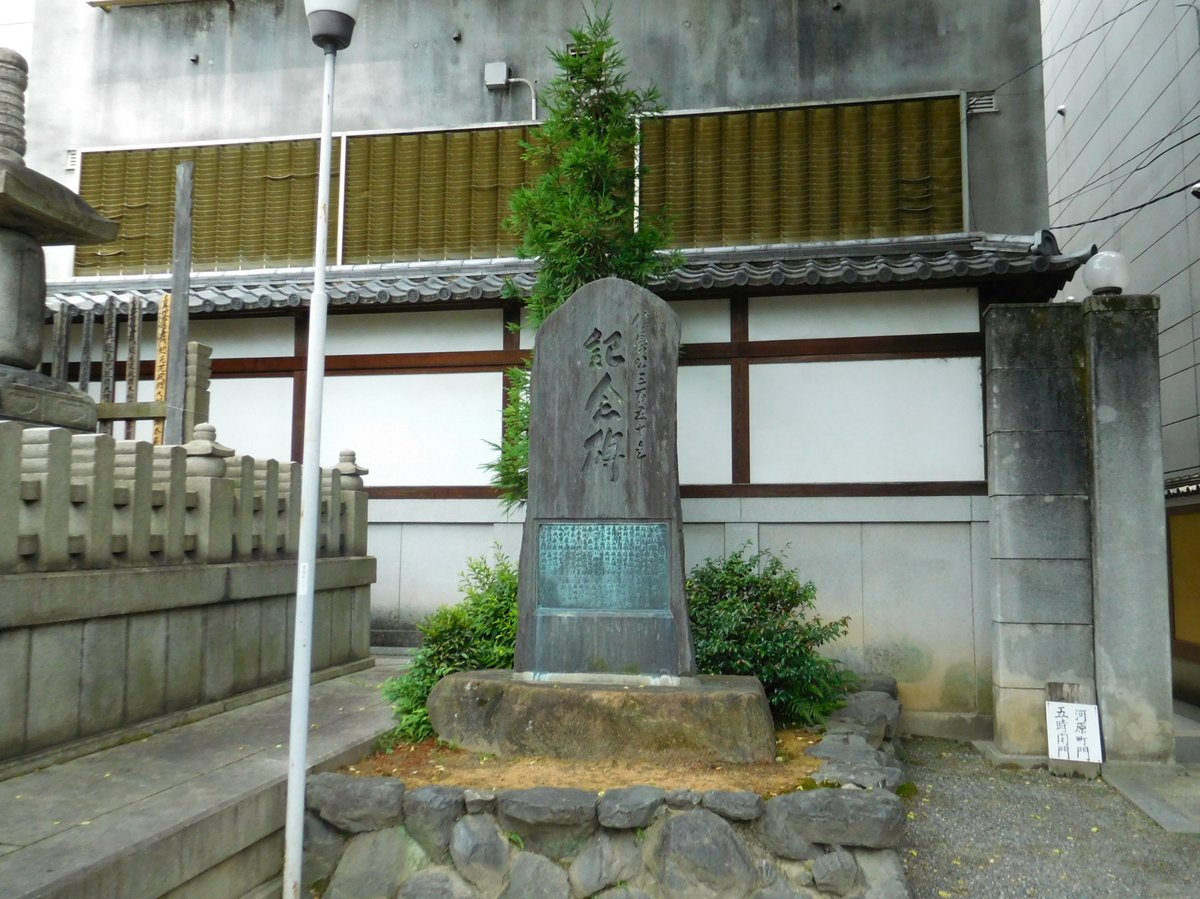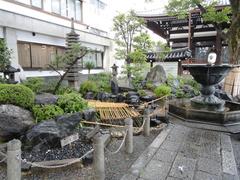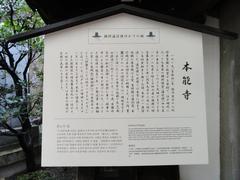
Honnō-Ji Kyoto Visiting Hours, Tickets, and Historical Significance Guide
Date: 14/06/2025
Introduction
Honnō-Ji Temple, located in the heart of Kyoto, is a nexus of Japanese history, culture, and spirituality. Established in 1415, this temple is most renowned as the site of the dramatic Honnō-Ji Incident of 1582, where the influential daimyo Oda Nobunaga met his end through betrayal—a moment that shifted the trajectory of Japan’s unification. Today, Honnō-Ji continues to serve as a vibrant place of worship and a living monument to the events and personalities that shaped Japan’s past. This guide offers a comprehensive overview—covering Honnō-Ji visiting hours, ticketing, historical highlights, cultural significance, travel tips, nearby attractions, and practical advice for making the most of your visit (Kyoto City Official Travel Guide; Japan Guide; NHK World; Inside Kyoto; Japan National Tourism Organization).
Contents
- Founding and Early History
- The Honnō-Ji Incident: Assassination of Oda Nobunaga
- Reconstruction and Relocation
- Cultural and Political Significance
- Architectural Features and Artifacts
- Visiting Hours and Ticket Information
- Travel Tips for Visiting Honnō-Ji
- Nearby Attractions in Kyoto
- Frequently Asked Questions (FAQ)
Founding and Early History
Honnō-Ji (本能寺) was founded in 1415 by the Nichiren Buddhist monk Sōon Nisshin during the tumultuous Muromachi period. Initially serving as a center for the Nichiren sect, the temple quickly established itself as both a religious and political hub, drawing influential figures from across Japan. Its original location in central Kyoto underscored its status as a significant meeting place for religious, military, and political leaders during the Sengoku (Warring States) period (Kyoto City Official Travel Guide).
The Honnō-Ji Incident: Assassination of Oda Nobunaga
The temple’s historical gravitas is inseparable from the Honnō-Ji Incident of June 21, 1582 (Gregorian calendar: July 2, 1582). Oda Nobunaga, on the verge of unifying Japan, was betrayed by his general, Akechi Mitsuhide, who led a surprise attack on the temple (Japan Guide). Vastly outnumbered, Nobunaga chose seppuku (ritual suicide) over capture, and the temple was set ablaze. This episode not only ended Nobunaga’s campaign but also paved the way for his successors, Toyotomi Hideyoshi and Tokugawa Ieyasu, to shape the nation’s future (NHK World; Sengoku Chronicles; Japan Experience).
Reconstruction and Relocation
After its destruction, Honnō-Ji was rebuilt and relocated to its current site in Teramachi, Nakagyō-ku, Kyoto, in 1591 as part of Toyotomi Hideyoshi’s citywide reorganization (Kyoto City Official Travel Guide). The present-day temple complex has undergone several reconstructions due to fires and other disasters, yet continues to serve as a functioning Buddhist temple and a memorial to Nobunaga.
Cultural and Political Significance
Honnō-Ji’s legacy as the site of Nobunaga’s demise has cemented its place in Japanese culture as a symbol of ambition, betrayal, and the volatility of the Sengoku era. The temple houses a memorial hall with a statue of Nobunaga and Sengoku-period artifacts, hosting annual ceremonies on the anniversary of the incident. This enduring legacy makes Honnō-Ji a pilgrimage destination for history enthusiasts and scholars alike (Japan National Tourism Organization).
Architectural Features and Artifacts
Although the original temple was destroyed, the reconstructed Honnō-Ji preserves essential architectural elements typical of the late 16th and early 17th centuries. The main hall (hondō) enshrines statues of Buddhist deities and features a revered image of Nichiren. Stone monuments mark the site of Nobunaga’s death, and a small museum displays armor, weapons, and historical documents from the Sengoku period (Inside Kyoto; Japan Experience).
Visiting Hours and Ticket Information
- Opening Hours: Honnō-Ji is generally open daily from 6:00 a.m. to 5:00 p.m., with last entry around 4:30 p.m. Hours may vary during special events, so check the official website or local tourism information for up-to-date details.
- Admission Fee: Entrance to the main temple grounds is free. Access to the treasure hall or special exhibitions requires a ticket (usually ¥300–¥800, depending on the exhibit).
- Tickets: Tickets for special areas can be purchased on-site at the temple entrance.
Travel Tips for Visiting Honnō-Ji
- Best Times: Visit on weekday mornings or late afternoons to avoid peak crowds, especially during cherry blossom (spring) and autumn foliage seasons (Travel Caffeine).
- Accessibility: The temple grounds are mostly flat and wheelchair accessible, though some older structures may have steps. Restrooms and vending machines are available.
- Guided Tours: English and Japanese guided tours offer historical context; audio guides may be available.
- Etiquette: Dress modestly, remove hats indoors, and take off shoes before entering indoor temple areas. Photography is allowed outdoors but restricted inside halls and during ceremonies.
- Cash and Language: Bring cash for donations and small purchases. Some signage is in English; translation apps are helpful.
Nearby Attractions in Kyoto
- Nishiki Market: A renowned food market located just south of the temple.
- Teramachi and Shinkyogoku Shopping Arcades: Bustling streets lined with shops and cafés.
- Kyoto International Manga Museum: A 10-minute walk west, popular with pop culture enthusiasts.
- Other Temples and Shrines: Close proximity to Kennin-ji, Yasaka Shrine, and historic Gion district for a broader cultural experience.
Alt text: Honnō-Ji Main Gate, historic Kyoto temple entrance.
Alt text: Map illustrating Honnō-Ji’s central location among Kyoto historical sites.
Frequently Asked Questions (FAQ)
Q: What are Honnō-Ji’s visiting hours?
A: Typically 6:00 a.m. to 5:00 p.m. daily, but confirm on the official website or local tourism boards for any changes.
Q: Is there an entrance fee or ticket required?
A: Admission to the temple grounds is free; the museum and special exhibition areas require a ticket (¥300–¥800).
Q: Are guided tours available?
A: Yes, both English and Japanese tours are available. Audio guides may be offered.
Q: Is the temple wheelchair accessible?
A: The grounds are mostly accessible; some traditional interiors may include steps.
Q: Can I take photographs at Honnō-Ji?
A: Photography is allowed outdoors. Please respect posted restrictions inside buildings and during ceremonies.
Q: How do I get to Honnō-Ji from Kyoto Station?
A: Take the Karasuma Line subway to Karasuma Oike Station and walk 10 minutes east to the temple.
Practical Recommendations
- Combine your visit to Honnō-Ji with nearby attractions like Nijo Castle and Nishiki Market for a full day of cultural exploration.
- Use a Kyoto City Bus & Subway One-Day Pass for convenient transit between historical sites (Trip to Japan).
- Support local businesses by shopping at nearby markets and enjoying regional cuisine in Teramachi and Gion.
Sustainability and Responsible Visiting
- Respect the temple’s tranquility—maintain quiet, avoid littering, and do not disturb the gardens.
- Participate in cultural experiences such as tea ceremonies or seasonal events to deepen your connection with Kyoto’s heritage (Magical Trip).
Summary and Final Recommendations
Honnō-Ji Temple is a must-visit for anyone interested in Japan’s history, culture, and spirituality. Its central location, free general admission, and wealth of historical artifacts make it accessible to all visitors. By planning ahead, observing respectful etiquette, and exploring nearby Kyoto sites, you will fully appreciate the legacy and living tradition of Honnō-Ji. For the latest information on visiting hours and events, consult official resources (Kyoto City Official Travel Guide; Kyoto Visitor’s Guide; Japan National Tourism Organization).
Download the Audiala app for audio guides, updates, and exclusive content to enrich your Kyoto journey!
Sources
- Kyoto City Official Travel Guide
- Japan Guide
- NHK World
- Inside Kyoto
- Japan National Tourism Organization
- Sengoku Chronicles
- Japan Experience
- Kyoto Kanko Net
- Japan Travel
- Kyoto Visitor’s Guide
- Travel Caffeine
- Trip to Japan
- Magical Trip














































































